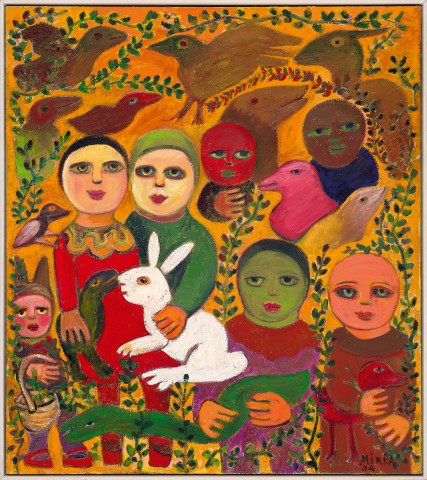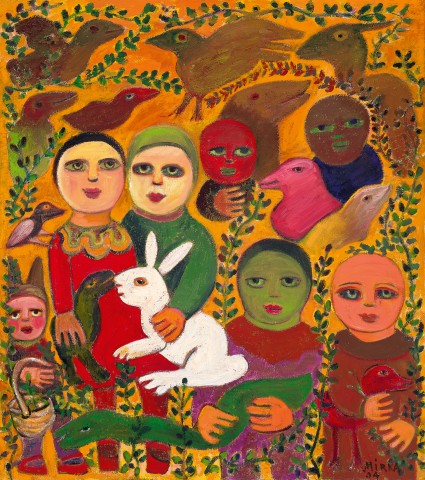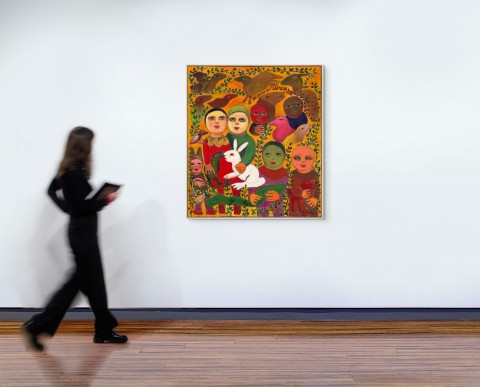THE WHITE RABBIT AND FAMILY, 2004
MIRKA MORA
oil on canvas
124.5 x 110.5 cm
signed and dated lower right: MiRKA / 04
signed, dated and inscribed with title and dated verso: MIRKA MORA / THE WHITE RABBIT AND FAMILY / 2004
William Mora Galleries, Melbourne (stamped verso)
Private collection, Melbourne, acquired from the above in 2004
Leonard Joel, Melbourne, 5 December 2010, lot 57
Private collection, Melbourne
Mirka Mora Recent Paintings, William Mora Galleries, Melbourne, 26 May – 19 June 2004
This work is accompanied by a letter from the artist to the original purchaser.
While rightly celebrated around the country for her idiosyncratic and highly whimsical work, Mirka Mora remains a particular Melbourne phenomenon, much loved by the city and its people, many of whom feel a personal connection to the artist and the captivating joie de vivre for which she was known. Indeed, some of Mora’s most recognisable works are now part of the city’s fabric – the Flinders Street mural, created in 1986; the murals in the Tolarno Hotel in the bayside suburb of St Kilda; the Children’s Mural in the St Kilda Library, which was created for the 1982 St Kilda Festival, and the painted windows of Heide 1 – John and Sunday Reed’s original home, at Heide Museum of Modern Art. In 1978, Mora was also the first artist invited to paint a Melbourne tram. Mirka became as famous for her antics and high jinks as for her art, but behind the gleeful naughtiness and bum and breast flashing, was a widely read and serious artist who was deeply committed to her craft. Her joyful spirit filled and fuelled both her art and life, and her infectious, child-like curiosity and endless sense of wonder fed a fierce intellect and a voracious and passionate love of learning.
Born in Paris in 1928, Mirka, her husband Georges and son Philippe arrived in Melbourne from France in 1951, disguised, as Barbara Blackman wrote, ‘as a salesman for the new Continental Chicken Noodle Soup and a Parisian seamstress.’1 After settling into their new home in Grosvenor Chambers at 9 Collins Street – unbeknownst to them, in the former studio of Arthur Streeton2 – the pair went on to open Mirka Café in 1954, followed by Café Balzac in 1958 and Tolarno Bistro and Galleries in 1965 – European-style eateries that were central to transforming the city’s dining culture and sense of itself as a sophisticated, modern city. The Moras were also key to the reactivation of the Contemporary Art Society in Melbourne in 1953 and the establishment of the Gallery of Contemporary Art (later, Museum of Modern Art and Design) in 1956, becoming part of a close-knit circle of artist friends and collaborators which included John and Sunday Reed, Joy Hester and Gray Smith, and Charles and Barbara Blackman, among others. It was in this milieu that Mirka found both her confidence and voice as an artist.
The White Rabbit and Family, 2004 is painted in Mora’s characteristic frieze-like style with the composition’s assortment of figures and animals somewhat flattened and pushed up close to the picture plane, as if carved from the work’s surface. The artist’s highly personal iconography of wide-eyed children and fantastical beasts clearly reveals her interest in sources ranging from classical mythology to fables, fairy tales and folk art, with the magical possibilities of the natural world evoked through the vines that entwine and possibly protect (or hide) her subjects.3 At the centre of the image is the majestic white rabbit, a symbol of longevity in Chinese culture, and a sign of vitality, rebirth and fertility in western art. However, it is fitting to remember in the context of Mora’s work that in Lewis Carroll’s Alice’s Adventures in Wonderland (1865), it is the White Rabbit that leads Alice down to the rabbit hole into a strange and surreal world, full of surprise, fear, confusion and delight.
1. Blackman, B., Glass After Glass: Autobiographical Reflections, Penguin Books, Ringwood, 1997, p. 169
2. As Mora later recalled, ‘Mrs Lina Bryans, a painter of note, also wanted the studio. I didn’t know her history then, or the studio’s, but later when I did I realised she must have been sad to miss out on the studio. It had been the studio of Arthur Streeton, Tom Roberts, Frederick McCubbin, Sir John Longstaff, Jane Sutherland and Ola Cohn.’, in Mora, M., Wicked But Virtuous: My Life, Penguin Books, Ringwood, 2000, p. 50
3. As a child, after fleeing Paris with the approach of the German army, Mora hid with her family in the forest: see Mora, ibid., p. 11
KELLY GELLATLY


